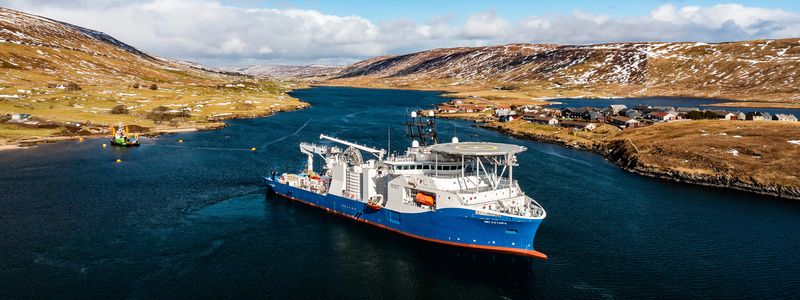NKT – NKT Victoria – Pushing the boundaries of cable installation
The transition to renewable energy is one of the most critical challenges of our time.
As the world shifts toward more sustainable power sources, the infrastructure that supports this transformation must evolve as well.
High-voltage power cable systems are a fundamental part of this change, connecting offshore wind farms, interconnectors, and other renewable energy projects to the grid. At NKT, we recognize that installation of these cables is just as important as the cables themselves. This is where NKT Victoria comes in.
By Ulf Andersson, Senior Vice President & Head of Installation in NKT.
NKT Victoria is more than just a cable-laying vessel— she represents a new approach to cable installation, one that prioritizes precision, efficiency, and sustainability. Unlike many other cable-laying vessels, where the ship’s design is set first and the cable-laying equipment is adapted to fit, we took the opposite approach.
As experts in power cables, we specified the cable-laying equipment first, ensuring it met the highest technical standards for handling and installation. Only then was the vessel designed around it, creating an optimized solution that seamlessly integrates cutting-edge cable technology with marine engineering. This approach allows us to install subsea and underground cables with minimal environmental impact while maintaining the highest standards of reliability and safety. Its dynamic positioning systems and advanced handling equipment allow us to work in complex conditions, ensuring smooth project execution even in the most challenging environments.
SourceNKT
EMR Analysis
More information on NKT: See the full profile on EMR Executive Services
More information on Claes Westerlind (President and Chief Executive Officer, NKT): See the full profile on EMR Executive Services
More information on Ulf Andersson (Senior Vice President & Head of Installation, NKT): See the full profile on EMR Executive Services
EMR Additional Notes:
- Extra Low-Voltage (ELV):
- Voltage of 50V or less (AC RMS), or 120V or less (ripple-free DC).
- Low-Voltage (LV):
- The International Electrotechnical Commission (IEC) defines supply system low voltage as voltage in the range 50–1000 V AC or 120–1500 V DC.
- Medium-Voltage (MV):
- Medium-voltage circuit breakers rated between 1 and 35/72 kV.
- High-Voltage (HV):
- The International Electrotechnical Commission define high voltage as above 1000 V for alternating current, and at least 1500 V for direct current.
- Super High-Voltage or Extra High-Voltage (EHV):
- Is >300kV.
- Ultra High-Voltage (UHV):
- Is >1.000kV.
- Power Cable:
- A high-voltage cable (HV cable), sometimes called a high-tension cable (HT cable), is a cable used for electric power transmission at high voltage. A cable includes a conductor and insulation. Cables are considered to be fully insulated.
- The main difference between hv and lv cables is that high-voltage cables have more semiconductor layers and shielding layers than low-voltage cables. Therefore, high-voltage cables than low-voltage cable insulation layers are much thicker, and the structure is more complex, the process requirements are also high.
- Interconnectors:
- Interconnectors are high voltage cables that are used to connect the electricity systems of neighbouring countries. They allow us to trade excess power, such as renewable energy created by the sun, wind and water, between different countries.
- An interconnector (also known as a DC tie in the USA) is a structure which enables high voltage DC electricity to flow between electrical grids. An electrical interconnector allows electricity to flow between separate AC networks, or to link synchronous grids.
- Grid, Microgrids, DERs and DERM’s:
- The power grid is a network for delivering electricity to consumers. The power grid includes generator stations, transmission lines and towers, and individual consumer distribution lines.
- The grid constantly balances the supply and demand for the energy that powers everything from industry to household appliances.
- Electric grids perform three major functions: power generation, transmission, and distribution.
- A microgrid is a small-scale power grid that can operate independently or collaboratively with other small power grids. The practice of using microgrids is known as distributed, dispersed, decentralized, district or embedded energy production.
- Smart Grid is any electrical grid + IT at all levels . Micro Grid is a group of interconnected loads and DERs (Distributed energy resources) within a clearly defined electrical and geographical boundaries witch acts as a single controllable entity with respect to the main grid.
- Distributed energy resources (DERs) are small-scale electricity supply (typically in the range of 3 kW to 50 MW) or demand resources that are interconnected to the electric grid. They are power generation resources and are usually located close to load centers, and can be used individually or in aggregate to provide value to the grid.
- Common examples of DERs include rooftop solar PV units, natural gas turbines, microturbines, wind turbines, biomass generators, fuel cells, tri-generation units, battery storage, electric vehicles (EV) and EV chargers, and demand response applications.
- Distributed energy resources management systems (DERMS) are platforms which helps mostly distribution system operators (DSO) manage their grids that are mainly based on distributed energy resources (DER).
- DERMS are used by utilities and other energy companies to aggregate a large energy load for participation in the demand response market. DERMS can be defined in many ways, depending on the use case and underlying energy asset.


